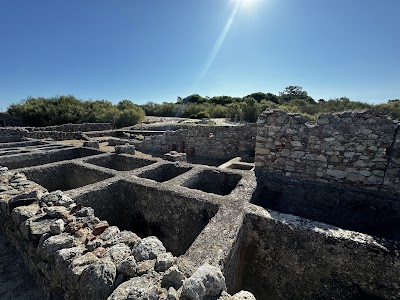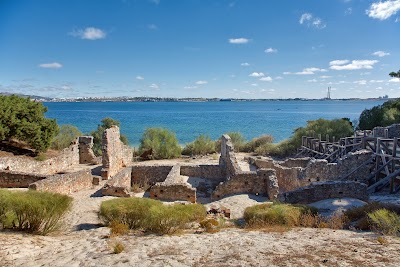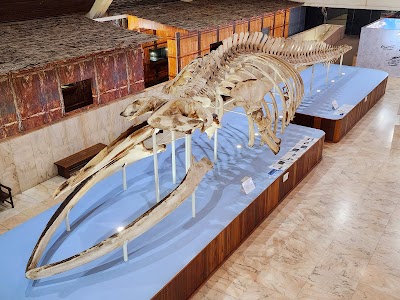Ancient Roman Ruins of Sabratha (أطلال سبراتة الرومانية القديمة)
Overview
Nestled in the Mediterranean region of North Africa, the ancient Roman ruins of Sabratha stand as one of Libya's most cherished historical treasures. This captivating archaeological site, located in the Sabha District, offers visitors a remarkable glimpse into the grandeur of Rome's far-reaching empire. Once a thriving metropolis, Sabratha is a testament to the rich cultural mosaic of the region, blending Roman architectural prowess with indigenous influences.
Sabratha's origins trace back to the 5th century BC when it was established as a Phoenician trading post. However, its true flourishing began under Roman rule in the 1st century BC. The Romans expanded the city dramatically, endowing it with monumental structures and transforming it into a vital port city that played a key role in Mediterranean commerce.
One of the most mesmerizing sights in Sabratha is its remarkably well-preserved theater, built in the 2nd century AD. This architectural masterpiece could originally seat up to 5,000 spectators, with a stunning three-story backdrop adorned with intricate carvings and classical columns. As you stroll through the sunlit arches and marble staircases, you may find yourself imagining the echoes of ancient performances and the vibrant life of bygone eras.
Adjacent to the theater lies the Forum, another central hub of ancient Roman life where critical decisions were made and societal matters discussed. The forum’s impressive colonnades and remaining statues provide a window into the civic and social dynamism of Sabratha. Nearby, the Capitolium Temple, dedicated to the triad of Jupiter, Juno, and Minerva, rises majestically, exemplifying both the religious devotion and the architectural skills of Roman engineers.
Another highlight of Sabratha is the Basilica of Justinian, adorned with intricate mosaics that reflect the city's continuity and transformation through the ages. Named after the Byzantine emperor, this basilica showcases beautiful geometric designs and Christian symbols, illustrating a period of religious transition and cultural blending.
Adding to Sabratha’s allure are the numerous residential ruins, bathhouses, and market stalls, which paint a vivid picture of daily life for its ancient inhabitants. The remnants of expansive Roman baths, complete with elaborate heating systems, offer fascinating insights into the leisure and hygiene practices of the era. As you wander through the remains of once-opulent villas, you’ll find exquisite frescoes and colorful mosaic fragments, bringing the domestic life of the past to life.
Sabratha’s significance extends beyond its historical and architectural marvels. Its preservation offers crucial insights into the broader narrative of Roman North Africa and the interactions between Mediterranean and African cultures. The ruins stand as a poignant reminder of a time when Sabratha was a cosmopolitan hub of trade, culture, and learning.
Interestingly, the site was rediscovered by European explorers in the 19th century, leading to extensive archaeological excavations throughout the 20th century. Today, Sabratha is a UNESCO World Heritage site, recognized for its outstanding universal value and the urgent need for preservation.
For foreign tourists, the journey to Sabratha is a pilgrimage to a bygone world. Exploring these ancient ruins against the backdrop of the azure Mediterranean Sea is an unforgettable experience. While travel to Libya may require careful planning due to its contemporary political context, the extraordinary historical wealth of Sabratha makes it a must-visit destination for history enthusiasts and casual visitors alike.
To enhance your experience, consider hiring a local guide who can share detailed stories about each ruin and artifact. Curated tours often include narratives about the daily lives of Roman citizens, intriguing anecdotes about ancient political events, and insights into the complex engineering feats achieved by Roman builders.
Whether you are marveling at the grandeur of the ancient theater, tracing the intricate lines of a centuries-old mosaic, or pondering the architectural ingenuity of Roman engineers, a visit to Sabratha offers a profound connection to humanity's shared heritage. The ancient ruins, with their silent yet powerful presence, invite you to walk through history and appreciate the enduring legacy of one of Rome’s many gems on the African continent.
In conclusion, the ancient Roman ruins of Sabratha are not just static remnants of the past, but a dynamic window into the rich historical and cultural interplay of ancient civilizations. They exude a timeless charm that captivates the imagination, making for a memorable and insightful journey into antiquity.





